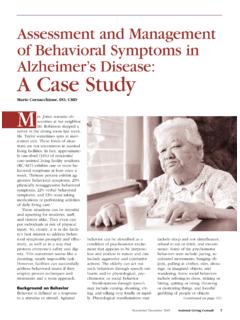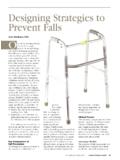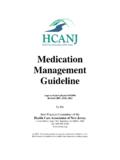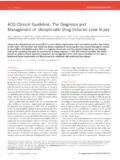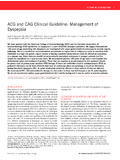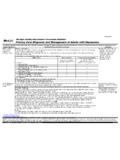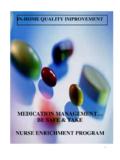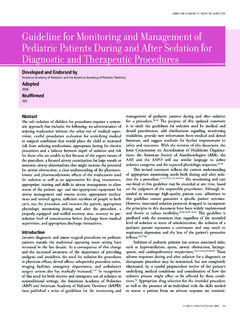Transcription of AMDA Clinical Practice Guideline: Pain Management in ALFs
1 28 Assisted Living ConsultMay/June 2005 This document focuses on themanagement of pain inALFs. It is based on theAmerican Medical Directors Associa-tion s (AMDA) Clinical Practice guide-line, pain Management in the LongTerm Care Setting. It recommendsprocesses that, if followed, will helpto ensure that pain among ALF resi-dents is adequately recognized,assessed, treated, and monitored. Ingeneral, guidance is directed to theentire interdisciplinary care size, available resources,existing policies and procedures, andother factors may influence the pre-cise manner in which a particular ALFimplements and uses these processes. DefinitionPain is defined as an individual sunpleasant sensory or emotionalexperience. Acute pain involvesabrupt onset or escalation. Chronicpain is persistent or recurrent. Painis a highly subjective, personal experience for which there are noconsistent objective biologicalmarkers. Despite the best efforts of practi-tioners and staff, pain is commonin the assisted living setting.
2 How-ever, although disorders that cancause chronic pain are more com-mon with increasing age, pain itselfis not a normal part of aging. Approximately 45-80% of longterm care (LTC) residents are esti-mated to have chronic pain . Theprecise figures are unknown, aspain in the long term care setting issometimes under-recognized andunder-treated; and treatment forchronic non-cancer pain , especiallyamong those with non-terminal ill-ness, is inconsistent. Nonetheless, pain in elderlypatients often can be reliably de-tected and effectively the recognition and treat-ment of pain in ALFs present spe-cial challenges, a systematic effortcan result in positive outcomes. Management of Acute Versus Chronic PainAlthough the principles of painmanagement are similar for bothAMDA ClinicalPractice Guideline: pain Management in ALFs May/June 2005 Assisted Living Consult29acute and chronic pain , someimportant distinctions exist in theirrecognition, assessment, treatment,and monitoring.
3 For example, thecauses and characteristics of chron-ic pain are more likely to havebeen identified previously. When aresident is in acute pain , however,both causes and characteristics ofthe pain should be identified asrapidly as possible. Whereas the necessary durationof interventions for the individualwith acute pain generally will lastonly until the pain resolves, indi-viduals with chronic pain common-ly need long-term interventions. Atthe same time, many individualswith chronic pain also have suddenand extreme exacerbations requir-ing a similar approach to that usedfor the treatment of acute to Recognizing pain in ALFsPain is under-recognized for manyof the same reasons that the earlysigns and symptoms of many otherconditions such as depression,congestive heart failure, and ad-verse effects of medications goundetected in ALF residents. Theseinclude: Different response Cognitive and communicationbarriers Cultural and social barriers Co-existing illnesses and multiplemedication use Staff training and access toappropriate tools Practitioner limitations System barriers Poorly functioning care process-es and teams Inadequate communicationamong interdisciplinary teammembers Insufficient commitment to painmanagementIn addition, several very specificreasons for the under-recognitionof pain are rooted in the nature ofpain and societal attitudes towardit.
4 pain is subjective and lacks con-sistent objective biological mark-ers. Numerous myths persist aboutpain in the elderly; and caregivers,residents, and families may holdmisconceptions that prevent themfrom providing or seeking ade-quate pain treatment (see Table 1).For example, residents may equatepain with serious illness and beafraid to report it or they may seepain as a sign of weakness. At thesame time, caregivers, family mem-bers, and even some practitionersmay hesitate to administer opioidsfor fear of getting the residentaddicted. It is the job of the facilitystaff and of the practitioner to re-lieve those fears and to dispel the myths that may exist aboutopioid most accurate and reliableevidence of the presence and inten-sity of pain is the resident s self-report. However, older people oftendescribe discomfort, hurting, aching,or soreness, rather than using thespecific word pain . Therefore, askthe resident using a variety of suchwords, (eg, Are you uncomfort-able?)
5 Or Do you ache? ) whenasking about pain . Chronic pain is usually not con-stant; it fluctuates over time in bothcharacter and intensity. Althoughstaff and practitioner assessmentsshould incorporate a resident s self-report of pain , additional directexamination is important in helpingto identify pain characteristics andpossible causes. Therefore, while apatient s self-report of pain shouldnever be ignored, this should onlybe one component of the diagnosis. It is important to note that a spe-cific cause of pain often cannot beidentified, even after diagnostic test-ing has been performed. In somecases, diagnostic testing to deter-mine the causes of pain may beprecluded (eg, when a resident ora resident s decision-maker hasrequested that no diagnostic tests beperformed). However, pain shouldalways be addressed, even if itscause is to 45 80% of long term care residents are estimated to have chronic Misconceptions about pain in Elderly People To acknowledge pain is a sign of personal weakness.
6 (Conversely, to bear painwithout complaint denotes strength of character.) Chronic pain is an inevitable part of aging and nothing can be done about it. pain is a punishment for past actions. Chronic pain means death is near. Chronic pain always indicates the presence of a serious disease. Acknowledging pain will mean undergoing intrusive and possibly painful tests. Acknowledging pain will lead to a loss of independence. The elderly, especially the cognitively impaired, have a higher tolerance for pain . The elderly and the cognitively impaired cannot be accurately assessed for pain . Patients in long term care say they are in pain to get attention. Elderly patients are likely to become addicted to pain Living ConsultMay/June 2005 Description of pain in ALFsMost chronic pain in ALFs is relatedto arthritis and musculoskeletalproblems. Surveys have found thatnearly one in four residents in thelong term care setting has someform of arthritis.
7 pain caused bynervous system damage or disease,including diabetic neuropathy andpostherpetic neuralgia, also is com-mon as is pain associated withosteoporosis. pain can cause or lead to otherconditions that can adversely affectresidents independence, level offunctioning, and quality of include deconditioning, gaitdisturbances, falls, slow rehabilita-tion, multiple medication use, cog-nitive impairment, malnutrition,depression, sleep disturbance,impaired mobility, and decreasedsocialization. At the same time,chronic pain in elderly people alsocontributes to increased health careutilization costs. pain in Cognitively Impaired ResidentsPain frequently is undertreated incognitively impaired residents, partlybecause they are less able to expresstheir pain in words (eg, My handshurt. ). However, contrary to a com-monly held belief, these residentsoften are capable of communicatingabout their pain in other ways. Forexample, one study tested the abilityof cognitively impaired residents in along term care facility to completescales that used words or pictures todescribe the severity of found that more than 80% ofthe residents could complete at leastone of five scales.
8 Caregivers, family members, andothers should be encouraged tolook for signs that cognitively im-paired residents could be experi-encing pain . These include facialexpressions (grimacing, frowning),moaning, rubbing hands or otherbody parts, crying, and/or not eat-ing. It is important for all front-linestaff members to be educated aboutthese nondescript signs and symp-toms of pain so that they are betterable to identify when a residentmay be in pain . At the same time,even when they can t say directlythat they are in pain , their wordsmay suggest discomfort nonethe-less. Expressed memories about atime when they were hurt mayrelate to current pain they are feel-ing. For example, a resident mighttalk about a time when he fell outof a tree and broke his leg. Managing PainIt is suggested that clinicians take a start low, go slow approach totreating pain in ALF residents, witha focus on taking the least invasiveroute and reassessing nonpharmacologic and phar-macologic treatments have value intreating pain .
9 Nonpharmacological treatmentsinclude cognitive therapies, bio-feedback, and behavior therapy, as well as topical analgesics such as counterirritants and capsaicincream. A number of complementarytherapies also may be helpful (seeTable 2).A medication schedule is advisedfor pharmacologic treatments. Sever-al non-steroidal anti-inflammatorydrugs (NSAIDs) are considered inap-propriate for elderly include indomethacin, me-clofenamate, piroxicam, and tol-metin. Also considered inappropriatefor this population are the opioidsmeperidine, propoxyphene, penta-zocine, and nalbuphine, as well asphenylbutazone, trimethyl benza-mide, flurazepam, amitriptyline,long-acting benzodiazepines, musclerelaxants, and mild to moderate pain , con-sider a trial with , it is important to note thatcaution is necessary in administer-ing acetaminophen to patients whoalso are taking warfarin or whohave liver disease or alcohol abuseproblems. Studies have shown thatpatients often say they get greaterrelief from NSAIDs over aceta-minophens; and a combination ofacetaminophen and tramadol pro-vides greater pain relief than eitheralone and results in quicker painrelief than tramadol by itself.
10 Thiscombination also has the benefit ofreduced adverse drug immediate-release opioiddosing calls for a dose every fourTable Therapies for pain Management ALF should consider offering complementary therapies for pain Management , including: Physicial Therapies Exercise Physical and occupational therapy Positioning (eg, braces, splints, wedges) Cutaneous stimulation (eg, superficial heat or cold, massage therapy, pressure,vibration) Neurostimulation (eg, acupuncture, transcutaneous electrical nerve stimulation) Chiropractic treatments Magnet therapy Nonphysical Therapies Cognitive/behavioral therapy Psychological counseling Spiritual counseling Peer support groups Alternative medicine (eg, herbal therapy, naturopathic and homeopathic remedies) Aromatherapy Music, art, drama therapy Biofeedback Meditation, other relaxation techniques HypnosisMay/June 2005 Assisted Living Consult31hours, adjusted daily.
